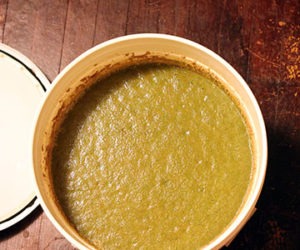Fermentation Temperature Control: Tips from the Pros
We all know it’s true, because it’s printed on the side of yeast packages — fermentation temperatures matter. Some yeast works better warm, some cold, but did you ever ponder what happens to your brew when temperatures fluctuate from warm to cold and back again? Our tipsters did and their ideas might someday help you out of a hot spot.
Brewer: Todd Ashman,Titletown Brewing in Green Bay, WI
Understanding what happens during fermentation when temperatures fluctuate better helps the brewer determine what needs to be done. The quality of the beer and vitality of the yeast both need to be examined.
The pitching temperature of wort depends on the yeast strain — some ale strains routinely start fermenting around 70 ºF (21 ºC) and others start much warmer. Fermentation is exothermic, which means it will create its own heat. Having the ability to cool the fermentation once it starts to take off is an imperative. I’ve heard of fermentations rising in temperature as much as 20 ºF (11 ºC) in six hours. The reality is if you aren’t keeping your fermenters cool, there may be a limit to what you can expect from your brewing efforts. However, since yeast growth and fermentations are exothermic and therefore generate heat, figure that the temperature within the fermenter can be as much as 8 °F (4 ºC) higher than outside of the fermenter during the early days of fermentation. So beers that are fermenting in refrigerators set at 65 °F (18 ºC) are most likely fermenting at about 72 °F (22 ºC).
If you pitch when the wort is on the cool side (below 70 ºF or 21 ºC), you face a sluggish start and leave yourself open to bacterial or wild yeast contamination. Obviously, brewing is a series of compromises — sort of a damned if you do, damned if you don’t type of practice — so be prepared.
If you have day-to-day environmental temperature changes in the 65–90 ºF (18–32 ºC) range, chances are, your beer isn’t actually cooling down that much.
The only time external temperature fluctuations may legitimately be a factor is during the first 12 hours of fermentation. If temperatures do swing drastically in these initial hours, the fermentation may become sluggish and a good deal of your yeast may drop out of suspension. The only way I could see this happening would be a major “environmental” change, like putting the fermenter in a very cold ice bath or refrigerator. This assumes that an adequate pitch of viable yeast was made and the wort was properly oxygenated.
There are a variety of methods of cooling down wort. If you just need to get the temperature down a few degrees, try applying cool towels around your carboy. If you are looking for more of a shift, immerse about half the height of the carboy into an ice bath to cool it.
Temperature will also affect the rate of growth of the yeast. If the temperature is too high, yeast growth will be too vigorous, producing an excessive demand on nutrients and your beer will be depleted in these nutrients. This can have an effect on subsequent conditioning.
In addition to this, and probably more importantly, a higher growth temperature will change the yeasts metabolism, producing a different range of by-products, which can have a major effect on flavor. If the temperature is too cool, the fermentation will be sluggish, resulting in an opportunity for the growth of contaminants, such as wild yeast and bacteria.
In terms of fermentation, lager yeasts are routinely fermented between 40–54 °F (4–12 ºC) while ale yeast is used from 55–70 °F (13–21 ºC). The optimal fermenting temperatures of yeast vary considerably.
Some ale yeasts for example, do not perform well below 65 °F (18 ºC). The Narragansett (Chico) strain is notorious for this, as well as certain Belgian and wheat beer strains. Common symptoms of fermenting too cold are stuck fermentations, poor attenuation (high finishing gravities) and off-flavors — especially diacetyl.
If you want to ferment cold, it may be necessary to acclimate your starter to a lower temperature to prevent cold shocking them. This can be done by slowly lowering the temperature of the starter the day before.
Brewer: Jesse Williams, New Albanian Brewery in New Albany, IN
Monitoring temperature and responding appropriately to shifts throughout the brew cycle, particularly during the fermentation period will make or break your beer. So, my first tip, if you do not already possess one, get yourself a thermometer! A typical bi-metal meat thermometer will suffice, but many floating and digital models are also available. Whatever thermometer you get, calibrate it to 32 ºF (0 ºC) degrees in 50/50 ice and water, and you’re ready to go.
Yeast lives and dies according to the temperature, so be aware of yours! Most strains of brewer’s yeast can survive temperatures in excess of 110 ºF (43 ºC), but it’s not a good idea to let your brew get anywhere close to that extreme. Unless your yeast strain is geared for warmer temperatures, pitching should be commenced around 70 ºF (21 ºC), with plenty of oxygen incorporated. A cold water fed garden hose and a wort chiller should get you close to this temperature.
A little clear thinking can lessen the fluctuating fermentation temperatures common in homebrewing. Never under any circumstances leave fermenting beer where the sun can get to it. UV light can skunk a hoppy beer while it’s still fermenting. A dark basement or closet that stays within a reasonable temperature range is a decent place. Yard sales and classified ads can also yield serviceable old refrigerators for the garage that make temperature controlled brewing much more convenient. Home refrigerators always have some temperature fluctuation, but a small standing thermometer can give you a good idea what’s going on in there. Any working refrigerator has less temperature fluctuation than the floor of your garage.
All right, so you still can’t control your temperatures and don’t feel like spending the money on your grandmother’s old refrigerator. You and your homebrew do have the option to coexist and cooperate with mother nature. Simply put, follow the seasonal temperatures of your climate and brew accordingly. In the warm summer months, brew crazy Belgians (in which yeasts can withstand temperatures of 80 ºF/27 ºC) and save your winter months for lagers who like it cold.



